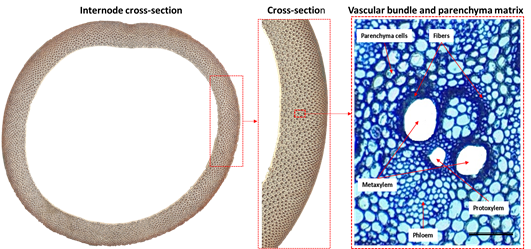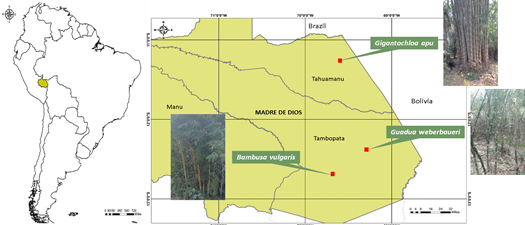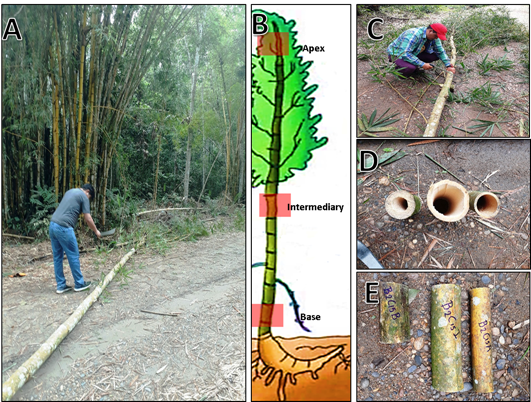1. Introduction
Bamboos are known as the largest grasses in the world; they belong to the Poaceae family and the Bambusoideae subfamily, they have a wide distribution, with around 1000 species distributed in Asia, Africa, America and Australia in the world (Ortíz, 2017).
The bamboo commonly known as "Cañas Guayaquil", "Maronas" "Pacas", or "Guaduas", depending on the characteristics of the place where it grows naturally or is cultivated, is a kind of cane that due to its size, resistance and flexibility come from being considered as an alternative material for housing construction (Rusch et al., 2020). Indeed, experiences in Ecuador, Costa Rica and Colombia indicate that the so-called guadua cane is an excellent renewable resource, fast-growing, and easy to manage, which provides economic, social, and environmental benefits to rural communities in Latin American countries (Estacio, 2013).
Studies on the anatomy, physical properties, and mechanical properties of bamboo have been conducted in countries such as Costa Rica, Mexico, Colombia, and Brazil. The research has revealed that bamboo culms are highly heterogeneous and anisotropic, as demonstrated in studies by Montiel et al. (2006); Ordóñez & Bárcenas (2014); Osorio et al. (2007); Rodrigues et al. (2020); Zaragoza et al. (2014). In addition, the microstructure of bamboo provides excellent mechanical properties (Wang et al., 2022).
In recent years, the study of the three-dimensional structure of bamboo cells has been conducted to optimize its utilization (Lian et al., 2021; Wang et al., 2022). Furthermore, research on the cell wall of bamboo parenchyma is being expanded upon (Lian et al., 2022). The general architecture and pore system of bamboo are also being examined to improve our understanding of its biomechanics, as well as the efficiency and safety of fluid transport through it (Liu et al., 2022) (Figure 1). This contemporary research is helping to make bamboo an even more suitable material for various applications.
Bamboos in Peru are abundant (MINAGRI, 2008) and in recent decades these species have become important for their technological and silvicultural properties in the world, however, in our country the technical information about these bamboos is not well known. For this reason, its use is incipient or insignificant (Monge et al., 2019) and simply the Pacas or Bamboo forests are considered an obstacle in forest use and we do not know the industrial potential of these bamboo species in our country.
In the Madre de Dios region, there is still a lack of information about bamboo at all levels of research, which represents the potential for future studies. The lack of knowledge about the anatomy and technological properties of bamboo is a justification for its limited use in the region, despite its proven diversity of uses. That is why the present investigation proposed to characterize the anatomy and longitudinal variation of the physical properties of the three bamboo species in the Madre de Dios region.
2. Materials and methods
Study area
Was sampled bamboo canes at three locations in the tropical moist forest of the department of Madre de Dios in southeastern Peru. Three species of bamboo were collected, Bambusa vulgaris, collected in the district of Tambopata, Castañal sector, kilometer 16 Interoceanic highway towards Puerto Maldonado-Cusco. Gigantochloa apus was collected in the Tahuamanu district, Maranguape sector, kilometer 135 Interoceanic highway towards Puerto Maldonado-Iberia. Finally, Guadua weberbaueri, was collected in the marginal area of the El Bosque estate, kilometer 16.5 Interoceanic highway towards Puerto Maldonado-Iberia. Figure 2 shows the location map of the collection areas.
Field phase
Based on the Peruvian Technical Standard (NTP N°251.008, 2016), three canes were collected by bamboo species from different plants that had the largest diameter at breast height, of the entire plant and that were found to be in good phytosanitary and were as straight as possible. Once the study areas were located, an inventory of the bushes of each bamboo species was carried out and three bushes of each species were selected. From the bushes, one culm per species was selected (Figure 3) that had good phytosanitary status, as straight as possible with the largest possible diameter, that is not dry, without rot, fungal attack, or ends.
To avoid damage to the culms when felling it, a special pruning saw was used so that it would not be damaged. Next, the total height of the culm was measured, and it was divided into three positions in the culm (base, intermediate, and apex), as shown in Figure 5. From each zone, two internodes per zone were obtained, coded, and bagged in a plastic bag to prevent rapid moisture loss.
Subsequently, the samples of the three bamboo species will be transported to the Wood Technology Pilot Plant of the National Amazonian University of Madre de Dios, where specimens of approximately 3x3x10 cm were obtained, both for anatomical characterization and physical properties.
Laboratory phase
Bamboos anatomy
The anatomy of the bamboo culms was carried out in the cross sections of the basal zone of each species and its anatomical structure was characterized, both at the macroscopic and microscopic level, the procedure used by the Wood Anatomy Laboratory of the University National Amazon of Madre de Dios. For the macroscopic level, sanding and polishing were performed (80, 100, 120, 220, 350, 450, 600, 100 g/cm2 sandpaper) of the entire cross-section of the culm of the base position, to highlight the vascular bundles. For the microscopic part, vessel diameter measurements were made, vessels per square millimeter. Finally, a photographic record was carried out using a Leica® EZ4D stereoscopic microscope to capture macro photographs, as well as a Leica® DM500 microscope to obtain microphotographs.
Physical properties of bamboos
The physical properties of the three bamboo species that were analyzed were: densities: basic, normal, and anhydrous; moisture content; contractions: volumetric (Table 1), the tests were carried out according to the specifications of the Peruvian Technical Standard.
Table 1 Peruvian Technical Standard for physical properties
| Property | Norma |
| Moisture content determination method | NTP N°251.010, 2016 |
| Density determination method | NTP N°251.011, 2016 |
| Shrinkage determination method | NTP N°251.012, 2016 |
Fuente: Portal (2008).
Ten specimens were used for each position of the culm per bamboo species, where their initial weight and initial volume were determined, said volume was determined by the water displacement or immersion method (precision balance Kern® 440-35N). The weight was determined with a precision balance Kern® PCB 200-2 of ± 0.01 grams. Afterward, the specimens were conditioned in the stove MMM® ECOCELL 55, and following the protocol, the temperature will be gradually increased from 30 °C to 103 °C ± 2 °C, with increments of 10 °C per day. During the time that the specimens were dried in the stove, the NTP stipulated was followed, daily checking the weight of each specimen, always placing them in the desiccator provided with silica gel. When the specimens reached their constant weight, the final volume was determined by the same method mentioned above and the following formulas were applied.
a) Determination of moisture content-MC%
NTP 251.010:2016: MC % = mh−mo mo ∗100 (Eq. 1), where mh: Weight of the moisture sample (g); mo: Weight of oven-dry specimen (g).
b) Determination of the basic density
NTP 251.011:2016: D= 𝑚 𝑉𝑠 𝑔/𝑐 𝑚 3 (Eq. 2); where D: Density of the wood in g/cm3; m: mass at a given CH (g); v: Volume at a given CH (cm3).
c) Determination of volumetric shrinkage
NTP 251.012:2016: CV % = 𝑉𝑠−𝑉𝑜 𝑉𝑠 ∗100 (Eq. 3); where Vs: Volume of the saturated Specimen (cm3); Vo: Volume of the oven-dry specimen (cm3).
Data processing
The data on the anatomy and physical properties of the three bamboo species were made with the RStudio software (RStudio Team, 2015). For the longitudinal variation of the physical properties, the ANOVA was performed (to see if there are differences between the positions) and the Tukey analysis was performed (to see how that difference is).
3. Results and discussion
Anatomy of the three species of Bamboo
Bambusa vulgaris Schrad. Former J.C. Wendl
Macroscopic Characteristics: the vascular bundles of B. vulgaris, visible to the naked eye (Figure 4/1), are easily differentiated from the parenchymal tissue due to their darker, light brown coloration and characteristic shape, being found in groups, being more numerous close to the outer region of the culm and smaller. In the inner region, they are in small quantities, but they are larger (Figure 4/1), so the inner part of the culm wall normally has low density. About the parenchymal tissue, it is cream-yellow, being more abundant in the innermost layers of the culm, decreasing in the direction of the outermost layer, and its purpose is to store water and starch, which is why it is easily attacked by bacteria and fungi and insects. The parenchyma tissue surrounds the vascular bundles of the bamboo.
Microscopic characteristics: the vascular elements of B. vulgaris, in the external region, have small diameter values (26.06 µm) and in the internal region they have large diameter values (53.87 µm), on average the diameter of the vessel elements (39.71 µm), in the internal region they have small diameter values (78.12 µm) and in the internal region they have large diameter values (115.60 µm), on average the diameter of the vessel elements (98.81 µm) (Figure 4/1). The frequency of the vascular elements varied from 15 to 18 vessels mm-2 and the average was around 16 vessels mm-2. The vascular bundle presented by B. vulgaris is of type III and IV. It was observed that B. vulgaris presents moderately abundant parenchyma cells filled with starch granules (Figure 4/1).
Gigantochloa apus (Schultes) Kurz.
Macroscopic Characteristics: the vascular bundles of G. apus, visible to the naked eye, are easily differentiated from the parenchymal tissue due to their darker brown coloration and characteristic shape (Figure 4/2), being found in groups, being more numerous close to the outer region of the culm and smaller. In the inner region, they are in small quantities, but they are larger (Figure 4/2), so the inner part of the culm wall normally has low density. About the parenchymal tissue, it is yellowish cream in color, being more abundant in the innermost layers of the culm, decreasing in the direction of the outermost bed, and its purpose is to store water and starch, which is why it is easily attacked by bacteria fungi and insects. Parenchymal tissue surrounds the vascular bundles of G. apus.
Microscopic Characteristics: The vascular elements of G. apus, in the external region, have small diameter values (82.30 µm) and in the internal region they have large diameter values (124.16 µm), on average the diameter of the vessel elements (100.68 µm), in the internal region they have small diameter values (97.69 µm) and in the internal region they have large diameter values (137.14 µm), on average the diameter of the vessel elements (114.69 µm) (Figure 4/2). The frequency of the vascular elements varied from 07 to 08 vessels mm-2 and the average was around 7 vessels mm-2. The vascular bundle presented by G. apus is type III. It was observed that G. apus has very abundant parenchyma cells filled with starch granules (Figure 4/2).
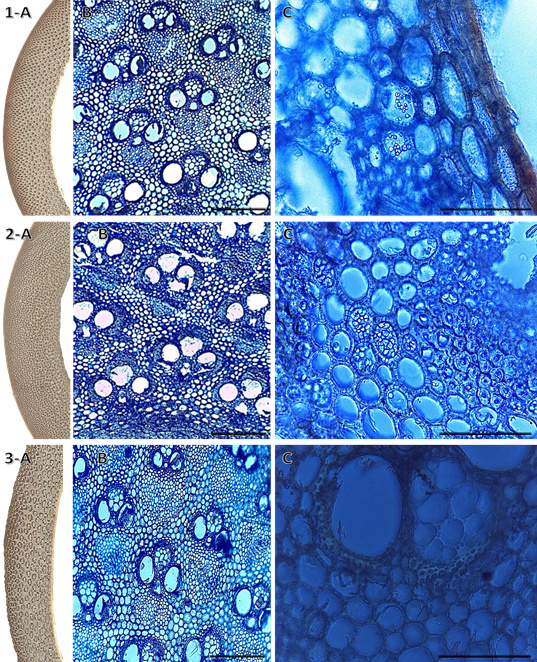
Figure 4 Anatomical characteristics of (1) Bambusa vulgaris, (2) Gigantochloa apus, (3) Guadua weberbaueri; (A) Macroscopic cross-section (1200 dpi resolution) (B) Microscopic cross-section (Scale bar = 250 µm), (C) cells filled with starch granules (Scale bar = 50 µm).
Guadua weberbaueri Pilg.
Macroscopic Characteristics: the vascular bundles of G. weberbaueri, visible with a 10x magnifying glass, are easily differentiated from the parenchymal tissue due to their darker, light brown coloration and characteristic shape (Figure 4/3), being found in groups, being more numerous nearby to the outer region of the culm and smaller. In the inner region, they are in small quantities, but they are larger (Figure 4/3), so the inner part of the culm wall normally has low density.
About the parenchymal tissue, it is cream-colored, being more abundant in the innermost layers of the culm, decreasing in the direction of the outermost layer, and its purpose is to store water and starch, which is why it is easily attacked by bacteria. fungi and insects. Parenchymal tissue surrounds the vascular bundles of G. weberbaueri.
Microscopic characteristics: the vascular elements of G. weberbaueri, in the external region, have small diameter values (35.80 µm) and in the internal region they have large diameter values (61.91 µm), on average the diameter of the vessel elements (48 .55 µm), in the internal region they have small diameter values (50.45 µm) and in the internal region they have large diameter values (87.04 µm), on average the diameter of the vessel elements (73.86 µm) (Figure 4/3). The frequency of vascular elements varied from 10 to 15 vessels mm-2 and the average was around 12 vessels mm-2. The vascular bundle presented by G. weberbaueri is type III. It was observed that G. weberbaueri presents parenchyma cells filled with very few starch granules (Figure 4/3).
The anatomy of the three bamboo species coincides with the scientific literature where the cross sections are characterized by the tissue of vascular bundles parallel to the longitudinal axis of the culm, housed in parenchymal tissue where, in addition, the density of the vascular bundle's increases in a radial direction. becoming more concentrated in the outermost part of the cross-section (Al-Rukaibawi et al., 2021; Gangwar & Schillinger, 2019).
Physical properties in the axial direction of three bamboo species
The results of the physical properties of the three bamboo species are presented in Table 2. For each property, the position in the culm and the general averages are shown.
Regarding Moisture Content, the species that did not show a statistically significant difference in the axial direction was G. weberbaueri, on the contrary, G. apus showed a significant difference in all axial positions, where the average moisture content for the species varied from 70.86% (G. weberbaueri) to 155.65% (B. vulgaris) (Table 2, Figure 5/A). Comparing the moisture content with the Guadua angustifolia species (57.9%), it is observed that the values are lower (Maya et al., 2017) and are mainly because was collected the samples and went directly to the laboratory without losing much time between collection and laboratory analysis. Compared with another study of the species Phyllostachys pubescens where they studied the moisture content in different axial positions, they found that the moisture content increases from the base to the apex as it happens with the species B. vulgaris (Berndsen et al., 2010).
Table 2 Average values, standard deviation, ANOVA, and Tukey's test for the physical properties in the axial direction of the three bamboo species
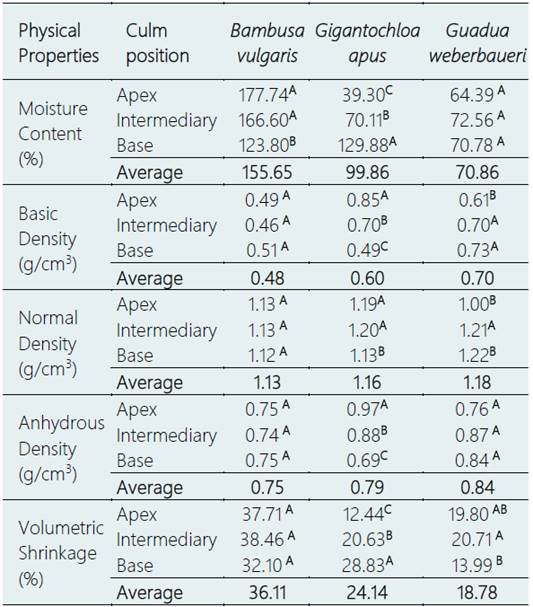
* Parameters with different letters differ statistically (p < 0.05).
Regarding the basic density, the species B. vulgaris did not show a significant difference, while on the contrary G. apus showed differences, it presented a significant difference in all axial positions, in general, the average basic density for the three species varied from 0.48 g / cm-3 (B. vulgaris) to 0.70 g/cm3 (G. weberbaueri) (Table 2,Figure 5/A). Comparing the basic density results of the three species with Guadua angustifolia (0.76 g/cm3), it is observed that the density values of the three bamboo species are lower (Maya et al., 2017), and may be due to various factors. factors such as age, place of study, etc. In addition, comparing the basic density with Bambusa tuldoides (0.66 g/cm3) it is higher than B. vulgaris and G. apus but lower than G. weberbaueri (Mbamu et al., 2020). Comparing with another study of the species Phyllostachys pubescens where they studied the basic density in different axial positions, they found that the basic density increases from the base to the apex as it happens with the species G. apus and this explains the reduction in the moisture content of the base to the apex of this species with a decrease in the lumens and an increase in the thickness of the walls of the fibrovascular bundles (Berndsen et al., 2010).
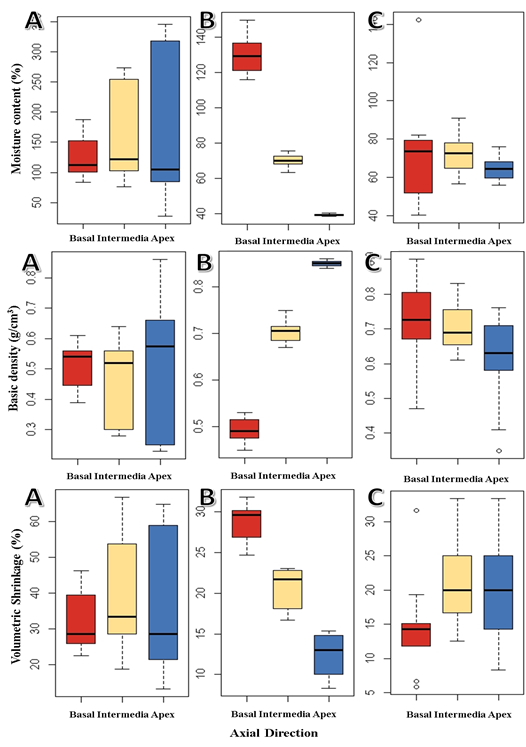
Figure 5 Physical properties of the three bamboo species. A) Bambusa vulgaris. B) Gigantochloa apus. C) Guadua weberbaueri.
Finally, regarding the volumetric contraction, the species B. vulgaris did not show a significant difference, while on the contrary, G. apus showed differences, it presented a significant difference in all axial positions, in general, the average volumetric contraction for the three species varied from 18.78% (G. weberbaueri) at 36.11% (B. vulgaris) at 36.11% (Table 2, Figure 5/A). Comparing the volumetric shrinkage with Bambusa tuldoides (18%) and Phyllostachys aurea (17%), only G. weberbaueri shows similar volumetric shrinkage, while the other two species studied are above these values (Mbamu et al., 2020). Comparing with another study of the species Phyllostachys pubescens where they studied the volumetric shrinkage in different axial positions, they found that the volumetric shrinkage increases from the base to the apex, however, this does not happen with any of the three bamboo species studied (Berndsen et al., 2010).
Ordóñez & Bárcenas (2014) studied three species Guadua aculeata, Guadua amplexifolia, and Guadua velutina (Table 4), where the authors analyzed the physical and mechanical properties in three positions of the base (B), middle (M) and upper end (E) culm. ), but in the upper end, they considered that the minimum diameter of the culms is 5 cm since they are no longer useful for construction if they are smaller than that diameter.
Comparing the results of Table 2, can observe, depending on the moisture content, that the three species of guaduas studied by Ordóñez & Bárcenas (2014), presented higher moisture content at the base of the culm, while the species studied in the present investigation only the species Gigantochloa apus, presented the highest moisture content at the base of the culm.
Regarding the position of the apex, it is observed that in the species studied by Ordóñez and Bárcenas (2014), the three species of guaduas presented lower moisture content, while the studied species Gigantochloa apus, and Guadua weberbaueri, presented lower moisture content in this culm position.
Comparing the basic density, it is observed that the three species of guaduas studied by Ordóñez & Bárcenas (2014), present lower basic density in the position of the base, while in the present study, only G. apus, presented lower basic density in the base. Regarding the position of the apex, it was observed that the species of guaduas studied by Ordóñez & Bárcenas (2014), presented a higher basic density in this position, while in the present study, it is observed that only G. apus, presented a higher density in this position.
Table 3 Basic density of some bamboo species
| Species | Basic Density (g/cm3) | Reference |
|---|---|---|
| Bambusa balcooa | 0.48 | 1 |
| Bambusa bambos | 0.48 | 1 |
| Bambusa polymorpha | 0.46 | 1 |
| Bambusa tulda | 0.48 | 1 |
| Bambusa tuldoides | 0.66 | 2 |
| Bambusa vulgaris | 0.48 | |
| Bambusa vulgaris var. striata | 0.45 | 1 |
| Bambusa vulgaris var. vulgaris | 0.46 | 1 |
| Dendrocalamus giganteus | 0.66 | 3 |
| Dendrocalamus strictus | 0.48 | 1 |
| Gigantochloa apus | 0.60 | |
| Gigantochloa levis | 0.68 | 4 |
| Guadua angustifolia | 0.71 | 5 |
| Guadua weberbaueri | 0.70 | |
| Phyllostachys aureas | 0.51 | 2 |
Crafted by the author, based on Thirunirai et al. (2017) 1; Mbamu et al. (2020) 2; Brito et al. (2015) 3; Wahab et al. (2016) 4; Correal et al. (2022) 5.
When comparing by genus (Table 3), was can see that Bambusa species have a basic density range of 0.45 to 0.66 g/cm3), with most species having a density of 0.48 g/cm3. Dendrocalamus species have a density range of 0.48 to 0.66 g/cm3. Gigantochloa species have a density range of 0.60 to 0.68 g/cm3 and Guadua species have a density range of 0.70 to 0.71 g/cm3. Phyllostachys aureas has a density of 0.51 g/cm3. In general, Guadua species have the highest density among the genera, followed by Gigantochloa and Dendrocalamus. Bambusa species have a lower density among the genera.
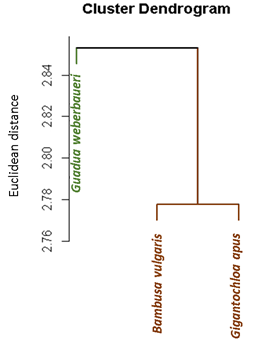
Figura 6 Dendrogram of Cluster Analysis (Euclidean distance) showing the different species of bamboo groups formed in relation to microscopic anatomy and physical properties.
According to the dendrogram of cluster analysis (Figure 6), based on the anatomy and physical properties of the three bamboo species, two groups were identified, showing that the species: B. vulgaris and G. apus form a group presenting more similar anatomical characteristics and physical properties between them and while G. weberbaueri forms another group and differs from the other two species in its anatomical characteristics and physical properties.
Most suitable uses of the three species of bamboo, based on the technological information obtained
According to the anatomy and physical properties, the three species of bamboo focused on uses can be used in B. vulgaris can be used in light construction, fishing rods, handicrafts, the paper industry, poles, props, scaffolding, utensils, musical instruments, etc. G. apus can be used in the construction of various structures, especially rural, decorations, veneers, handicrafts, pulp and paper, textile fiber, interior partition panels, etc. G. weberbaueri can be used in musical instruments, temporary constructions such as flying nurseries, handicrafts, basketry, charcoal (agricultural substrate), liquid purifier, etc.
4. Conclusions
Was shown that the three bamboos species present differences in their anatomical structure, the main difference between them being the vascular bundles of the culms. Regarding the physical properties, significant differences could be found between the three species. Regarding the axial direction of the culms, variations could be observed between the three positions studied. According to the grouping analysis, two species B. vulgaris and G. apus have similar characteristics, while G. weberbaueri did not group with the others. The uses of the three bamboo species are mainly related to their physical properties. Future studies should expand the knowledge of the technological properties of bamboo to contribute to the proper use of bamboo in tropical forests.














